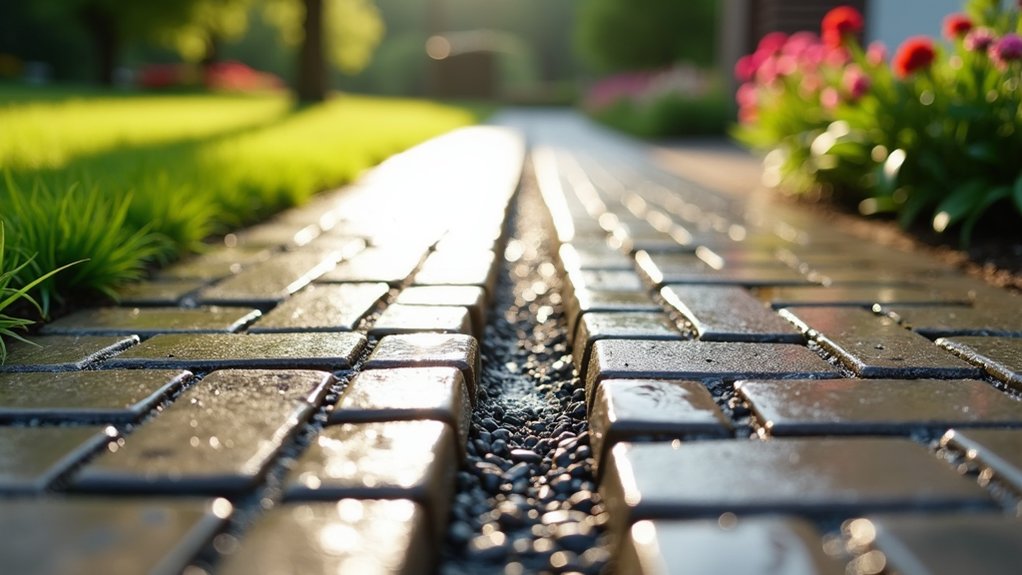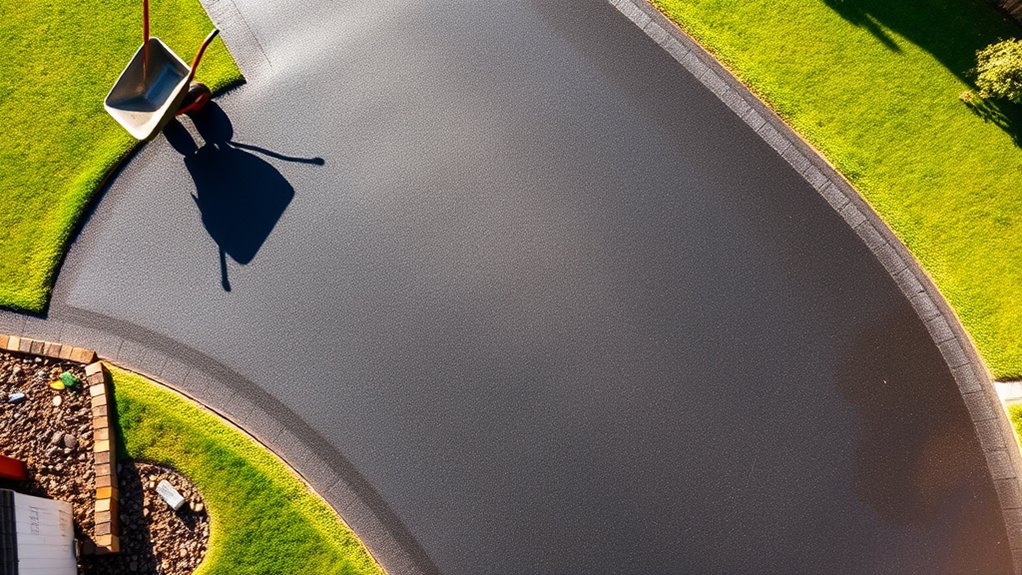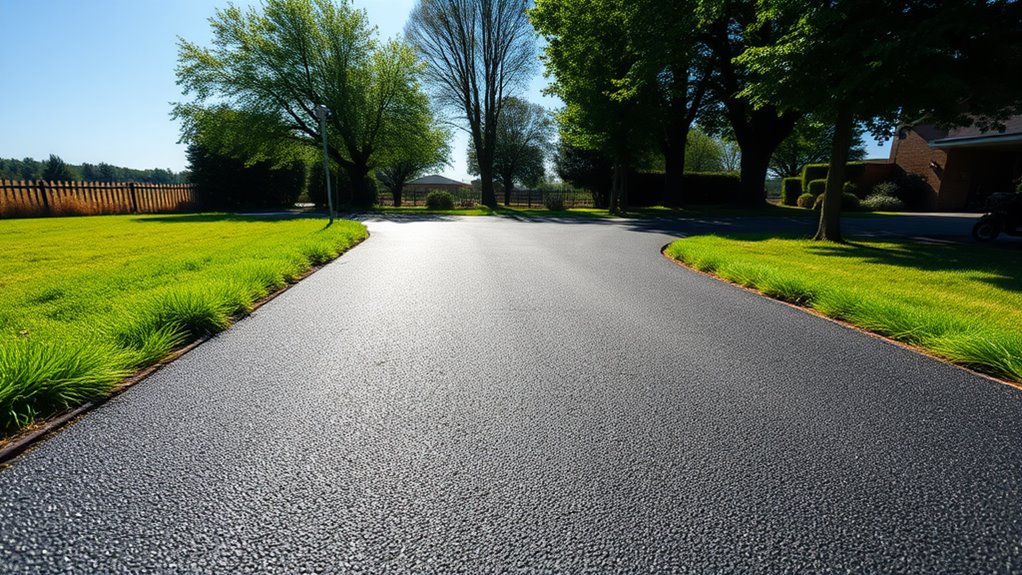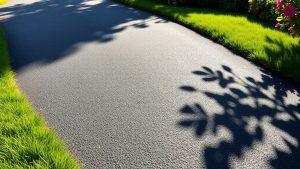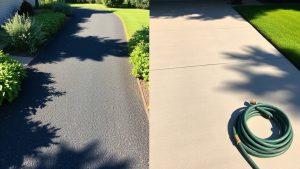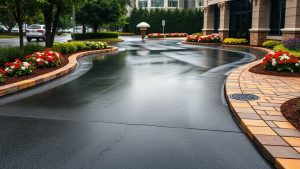To prevent water pooling on your driveway, start by checking for water sources such as blocked gutters and roof runoff. Assess the slope of your driveway to pinpoint any low areas where water tends to gather. Consider drainage solutions like French drains or permeable paving that suit your garden’s layout. Ensure the ground is properly prepared before installation, and keep your drainage systems well-maintained by clearing debris and checking for blockages regularly. By following these steps, you’ll improve drainage efficiency, ensuring your driveway remains dry and usable. More solutions are available if needed.
Table of Contents
ToggleKey Takeaways
- Ensure your driveway slopes away from the house to promote optimal water runoff and prevent pooling.
- Keep gutters and downspouts clear of debris to avoid blockages that can cause overflow towards your driveway.
- Consider installing drainage solutions like channel drains or permeable paving to improve water absorption and lessen runoff.
- Assess the surrounding landscape’s grading and make adjustments to direct water away from the driveway, reducing areas where water can collect.
- Regularly check for drainage issues and address them promptly to prevent minor problems from escalating.
Assessing the Water Sources
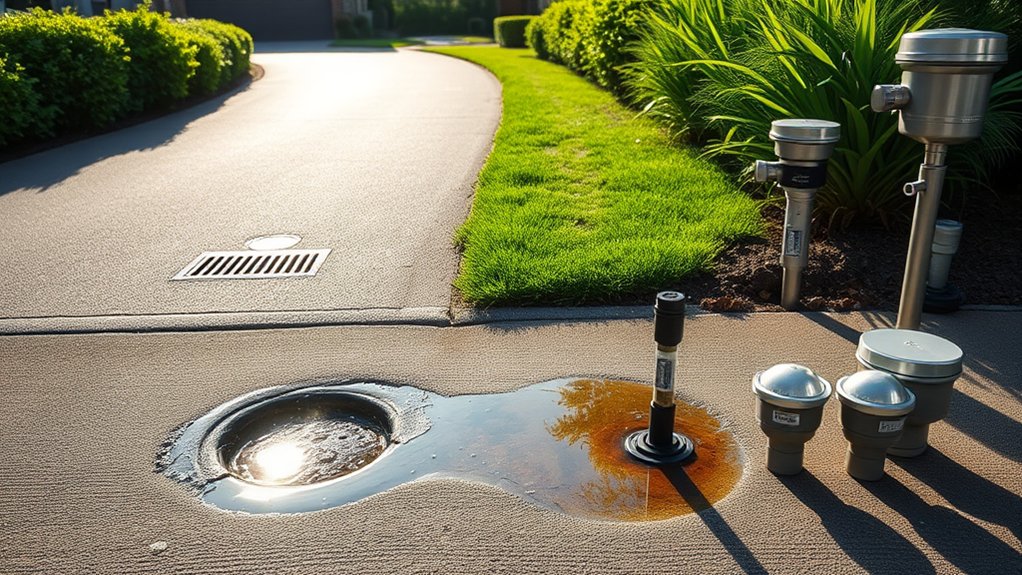
How can you effectively assess the water sources causing pooling on your driveway? Start by checking your gutter maintenance. Blocked gutters can overflow and direct water towards your driveway.
Look at the roof material, size, and pitch, as these affect runoff volume and speed. Installing gutter guards can help prevent debris buildup, and downspout extensions can redirect water away from your driveway.
Next, evaluate the surrounding landscape. Poor land grading might channel water towards your driveway, while dense plants can absorb runoff. Additionally, ensure that your driveway’s surface is free from existing damage that could impede proper drainage.
Make sure local stormwater management systems, such as culverts and drains, are functioning properly to reduce pooling. By systematically analysing these factors, you can pinpoint and tackle the water sources affecting your driveway.
Evaluating Driveway Slope and Low Spots
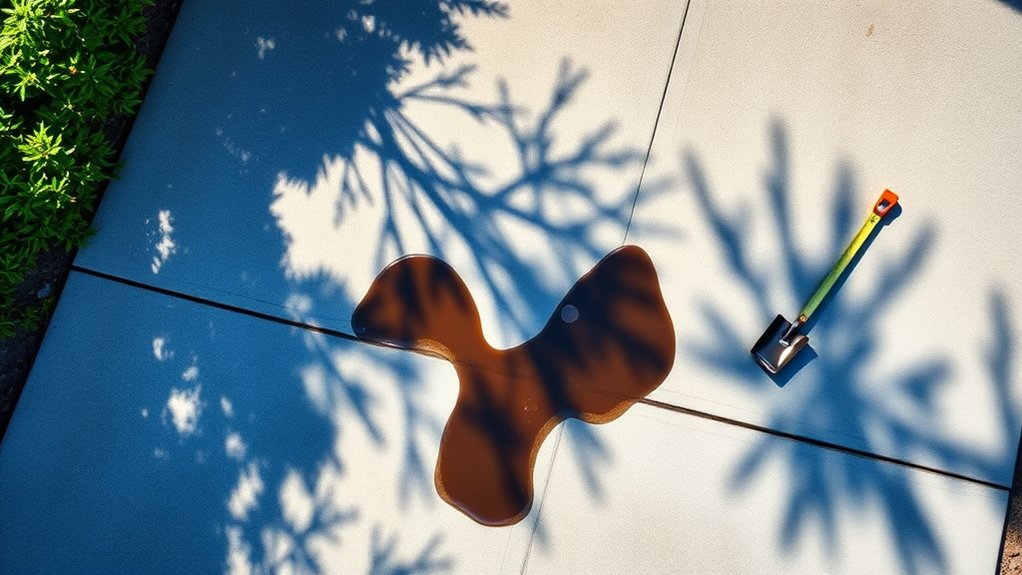
Once you’ve identified the water sources affecting your driveway, the next step is to evaluate its slope and any low spots that may cause pooling.
Here’s how to go about it:
- Measure the rise and run with a tape measure.
- Calculate the slope using the formula: Slope (%) = (Rise / Run) * 100.
- Look for low spots or areas where water tends to collect.
- Perform a simple water test—sprinkle water on the surface to see where it gathers. Regularly checking the driveway slope will help you pinpoint drainage issues effectively.
This straightforward approach will help you pinpoint drainage issues effectively.
Choosing the Right Drainage Solutions
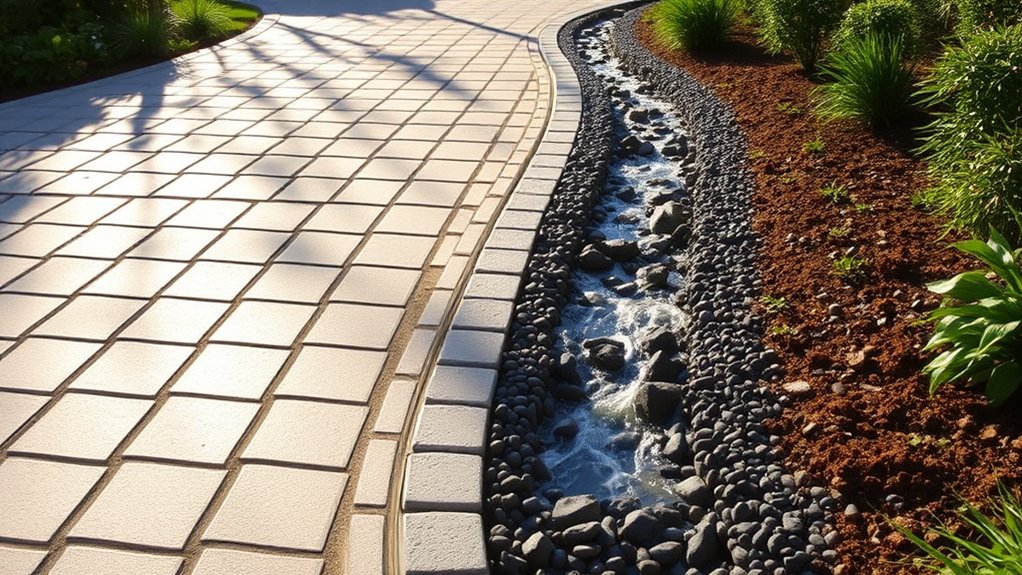
To choose the right drainage solution, assess your site conditions, such as soil type and existing drainage patterns. Compare options like channel drains, French drains, and permeable paving to find the system that suits your driveway best. This approach ensures efficient water management and helps prevent future pooling problems. Additionally, consider incorporating pervious pavements into your design, as they facilitate faster drainage and reduce surface runoff. Implementing SuDS drainage systems can further enhance the efficiency of your driveway’s drainage capabilities.
Assessing Site Conditions
When assessing site conditions for effective drainage solutions, it’s important to consider several key factors that impact water flow and pooling on your driveway.
Here are some points to keep in mind:
- Driveway Gradient: Ensure it slopes away from your property to direct water efficiently.
- Soil Type: Determine the types of soil present and their drainage capabilities to guide your solution choices.
- Water Flow Patterns: Observe how rainwater moves across your driveway to identify potential pooling areas.
- Surrounding Landscape: Evaluate features like retaining walls, as they can either impede or redirect water flow.
Additionally, incorporating a resin bound driveway can significantly enhance drainage capabilities, effectively reducing the risk of flooding.
Comparing Drainage Options
Choosing the right drainage solution for your driveway involves comparing different options, as each has its own pros and cons.
For channel drains, popular choices like the Swiftdrain Sierra Series and NDS Pro Series are effective at capturing water across larger areas, making them suitable for sloped driveways.
On the other hand, catch basins work well for properties without municipal stormwater connections, although they require more space for installation.
French drains and trench drains are also viable options; French drains filter water gradually, while trench drains effectively handle larger volumes of runoff.
Additionally, integrating permeable driveway options can enhance your drainage strategy by allowing water to infiltrate through the surface.
Assess your driveway’s specific conditions and drainage requirements to find the best solution for effective water management.
Preparing the Ground for Installation
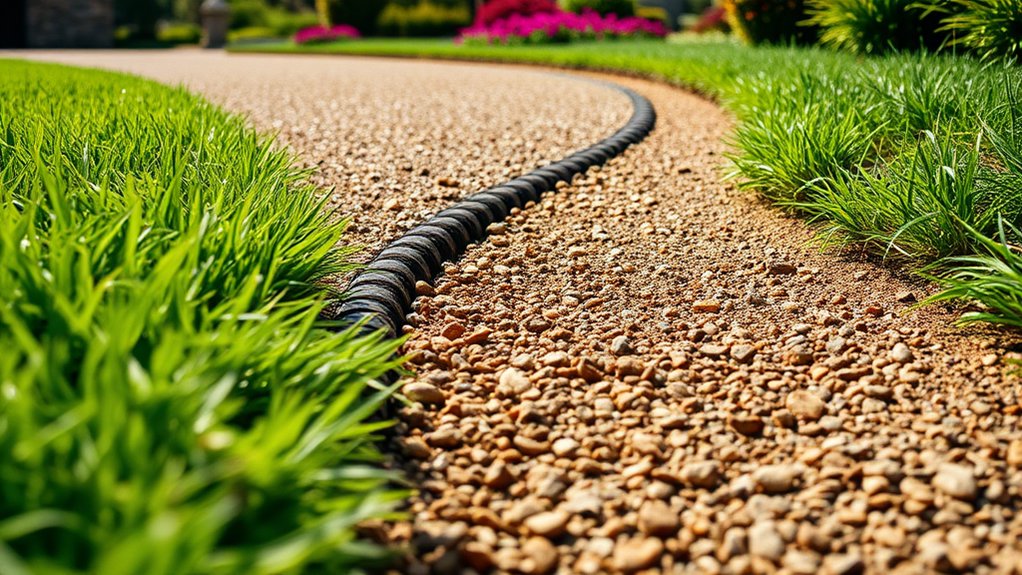
Preparing the Ground for Installation
Before starting your driveway installation, it’s crucial to prepare the ground properly for a stable and effective surface. Here are the key steps to follow:
- Initial Inspection: Check the area for any obstacles, such as tree roots or underground services.
- Soil Testing: Test the soil to determine its stability and composition, which will guide your sub-base preparation.
- Excavation Depth: Typically, you should excavate 20-30 cm (8-12 inches) to allow for the required sub-base and material thickness.
- Marking Boundaries: Use stakes and string to clearly outline the layout of your driveway.
Implementing Effective Drainage Solutions
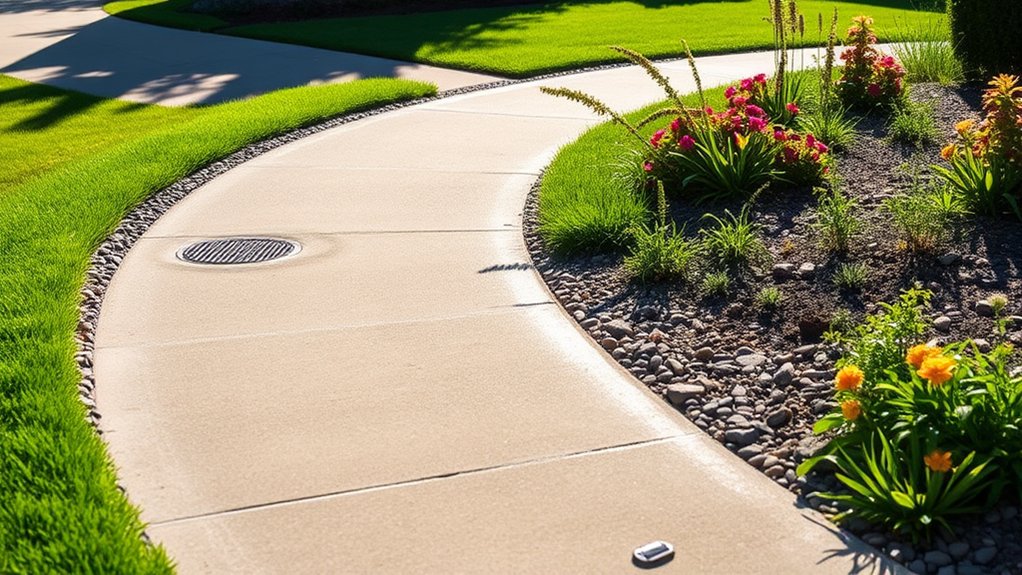
To prevent water pooling on your driveway, it’s crucial to select a drainage system that suits your specific site conditions.
Using quality materials will ensure durability and optimal performance.
Regular maintenance is also essential for the system’s longevity.
Choose Suitable Drainage System
To prevent water from pooling on your driveway, it’s important to choose the right drainage system for your needs. Here are four effective options to consider:
- Trench Drains: Best for areas that experience heavy rainfall, these drains handle large volumes of water efficiently.
- Channel Drains: A good fit for moderate rainfall, channel drains provide a narrower solution for directing water away.
- French Drains: These consist of gravel-filled trenches with perforated pipes to prevent groundwater damage, making them a reliable choice for many properties.
- Swales: Shallow ditches filled with plants can slow down runoff and improve drainage in your garden or yard.
Selecting the right type will help you manage water effectively and keep your driveway dry.
Install Proper Materials
Selecting the right drainage system is crucial, but using suitable materials is equally important to prevent water pooling on your driveway. Opting for permeable materials such as porous pavers or pervious concrete allows water to seep through the surface, which helps reduce accumulation. Gravel driveways not only filter water effectively but also offer an appealing aesthetic while lowering flooding risks.
Here’s a quick reference table:
| Material Type | Benefits | Considerations |
|---|---|---|
| Porous Pavers | Excellent drainage capacity | Higher initial cost |
| Pervious Concrete | Drains up to 10 cm per minute | Requires skilled installation |
| Gravel | Cost-effective and visually appealing | Needs occasional replenishing |
| Paver Stones | Facilitates water flow through gaps | May require regular upkeep |
| BaseCore Geocell | Efficiently reduces pooling | Professional installation recommended |
Choosing these materials can enhance the lifespan of your driveway and help minimise maintenance costs.
Regular System Maintenance
Choosing the right materials for your driveway is crucial for effective water management, but regular maintenance of your drainage system is essential to prevent water pooling.
Here are key practices to follow:
- Conduct annual drainage inspections to spot any damage, blockages, or sediment build-up.
- Clean drains and downspouts regularly to ensure proper water flow.
- Address any issues discovered during inspections promptly to avoid further complications.
- Keep a record of all maintenance activities for future reference and trend analysis.
Maintaining Your Drainage System
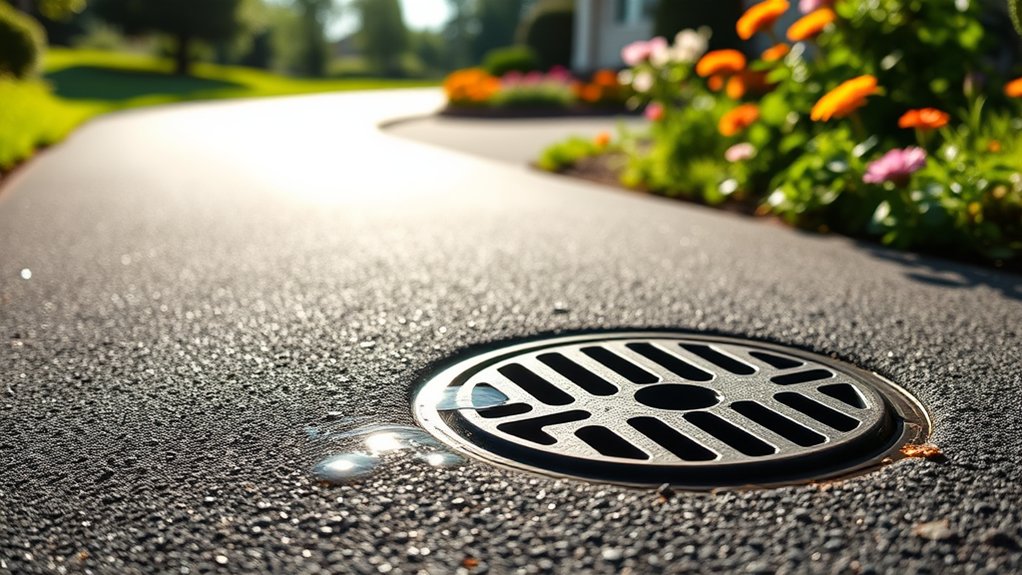
To ensure your drainage system operates properly, regular maintenance is crucial. Arrange for annual or bi-annual inspections to spot any damage or sediment build-up that might block water flow. Check drain grates, channel interiors, and pipe inlets for signs of wear. Clean drainage components several times a year to clear away debris that could hinder flow.
| Maintenance Task | Frequency | Tools Needed |
|---|---|---|
| Drainage Inspections | Annually or bi-annually | Inspection tools |
| Clearing Debris | At least every three months | Brooms, pressure washers |
| Repairs | As required after inspections | Repair kits, sealing materials |
Regular upkeep will help prevent costly issues down the line.
Frequently Asked Questions
How Can I Tell if My Driveway Needs Drainage Solutions?
To find out if your driveway needs drainage solutions, check the slope; it should guide water away from the property. Look for blocked drainage channels, standing water, and any cracks in the surface, as these can indicate poor water management. For instance, if you notice puddles forming after rain or water pooling near your garage, it’s a sign that drainage may be needed.
Are There Eco-Friendly Options for Driveway Drainage?
Yes, there are eco-friendly options for driveway drainage. Consider permeable pavers, which let water soak through, or rain gardens designed to manage runoff. Both solutions support sustainability while improving drainage and reducing environmental impact on your property.
What Are the Signs of an Effective Drainage System?
Consider your drainage system like a perfectly tuned orchestra. Signs of an effective system include no standing water, smooth water flow, clear drains, and no signs of erosion. These features ensure everything works in harmony, keeping your driveway usable and protecting your home’s foundation.
How Often Should I Inspect My Drainage System?
You should carry out drainage maintenance with seasonal inspections. For residential properties, aim for checks every two years. For commercial properties, annual inspections are crucial. Adjust your schedule based on local weather conditions and usage to ensure everything functions properly.
Can I Install Drainage Solutions Myself?
Yes, you can install drainage solutions yourself. Here are some essential tips: ensure you have the right tools, grasp the necessary skills, and maintain a proper slope for effective water management. For example, if you’re laying a French drain, aim for a gradient of at least 1% to direct water away from your property. Keeping it straightforward will help you achieve good results.
Conclusion
By assessing your water sources and the slope of your driveway, you’re already on the right track to preventing water pooling. However, it’s crucial to select and implement effective drainage solutions. When preparing the ground and installing your system, attention to detail is key. Will your efforts be worthwhile? With regular maintenance, you can ensure your driveway stays functional and free from water build-up. Take action now to safeguard your investment before the next downpour arrives.
How can a tarmac driveway enhance your home's appeal? Discover the key aspects of cost, installation, and maintenance in our Read more
Wondering if a tarmac driveway is the perfect fit for your home? Uncover the essential pros and cons before making Read more
Maximize the durability of your tarmac driveway by understanding the ideal weather conditions for installation—discover the secrets to perfect timing Read more

